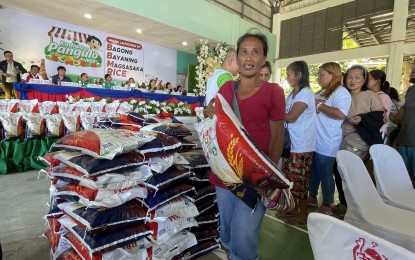
KEY FACTOR. Residents buy cheaper rice for PHP29 per kilo at the National Irrigation Authority in San Nicolas, Ilocos Norte on Sept. 13, 2024, part of the nationwide pilot program to sell quality and affordable rice initially to the vulnerable sector. In September, the Philippine Statistics Authority recorded 0.6 inflation rate in the Ilocos Region, slower than the previous month’s 1.8 percent mainly due to adequate food supply and rice importation. (PNA file photo by Leilanie Adriano)
MALASIQUI, Pangasinan – Rate of price increases in the Ilocos Region slowed to 0.6 percent in September this year from 1.8 percent in August primarily due to sufficient food supply, according to authorities.
Philippine Statistics Authority - Ilocos Region supervising statistical specialist Teresa Olarte said in a virtual forum on Friday that food and non-alcoholic beverages’ share to the downtrend in inflation in September was 80 percent, while transport contributed 20 percent.
Inflation rate for food and non-alcoholic beverages decreased from 2.8 percent in August to -0.3 percent in September.
Under the food groups, the inflation rate from August to September of rice decreased from 10.4 percent to 3.1 percent; from 24.4 percent to 16.7 percent for corn; and 3.2 percent to 3.1 percent for flour, bread and other bakery products, pasta products, and other cereals, Olarte said.
Fish and other seafoods' inflation also dropped to 0.2 percent from 1.3 percent and 3.1 percent from 2.7 percent for milk, other dairy products, and eggs.
National Economic Development Authority - Ilocos Region supervising economic development specialist Richard Mel Caplis said in the same forum that lower prices of food in the region, especially of rice and vegetables, were due to adequate supply of the products.
“The relative decrease was due to the abundance of food supply in the region, which is more than sufficient for the needs of the region,” he said in Filipino.
This was supported by Department of Agriculture (DA) - Ilocos Region project evaluation officer Irene Tactac who said that September was the start of harvest for wet cropping season, hence enough production of rice and other crops.
Based on DA data as of Oct. 4, there are 18,090 metric tons of rice harvested from 3,559 hectares in the region.
Caplis said lower tariff for the importation of rice also contributed to the decline of prices and eventually, its inflation rate.
“Executive Order No. 62 signed by President Ferdinand Marcos Jr. in June and implemented in July lowers tariff of rice, making importation easier and increasing supply of rice in the country and lowering the price,” he said.
Meanwhile, transportation’s inflation contributed 20 percent on the September inflation slowdown.
Olarte said lower gasoline and diesel prices are the main sources of deceleration.
On the other hand, meat and other parts of slaughtered land animals recorded higher inflation from 2.1 percent to 3.1 percent.
Fruits and nuts likewise registered an uptick from 3.8 percent to 7.5 percent, while ready-made food and other food products from 7.8 percent to 8.6 percent.
Among the provinces, La Union posted the highest inflation rate at 1.3 percent, followed by Pangasinan at 0.8 percent, and Ilocos Sur at 0.3 percent. Ilocos Norte was at -1.2 percent. (PNA)
